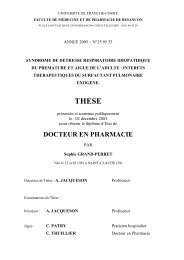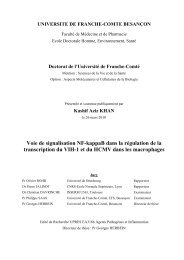THÈSE - Université de Franche-Comté
THÈSE - Université de Franche-Comté
THÈSE - Université de Franche-Comté
You also want an ePaper? Increase the reach of your titles
YUMPU automatically turns print PDFs into web optimized ePapers that Google loves.
organization for crop protection) surveys the communes and monitors the travelling wave<br />
dynamics of A. terrestris populations for outbreak control. Every commune is scored on a<br />
yearly basis with the following in<strong>de</strong>x: 0, no colony observed; 1, some isolated colonies; 2,<br />
colonies present in many pastures and meadows; 3, numerous colonies and serious damage to<br />
grassland. Thus, each parcel was also <strong>de</strong>fined according to the phase of the population cycle<br />
at scale commune.<br />
A TERRESTRIS AND T. EUROPAEA RELATIVE ABUNDANCE ESTIMATION<br />
The estimation of A. terrestris and T. europaea relative abundance on the parcel scale was<br />
based on an in<strong>de</strong>x method <strong>de</strong>scribed in Giraudoux et al. (1995). Such in<strong>de</strong>x methods,<br />
calibrated against <strong>de</strong>nsity estimates based on trapping, are usually employed for large scale<br />
studies (Hansson 1979; Delattre et al. 1999; Fichet-Calvet et al. 1999; Giraudoux et al. 1997;<br />
Quéré et al. 2000). The surface indices used here, were earth tumulus and occurrence of small<br />
mammal holes. A. terrestris presence can reliably be differentiated from T. europaea<br />
molehills. Relative abundance of A. terrestris and T. europaea was <strong>de</strong>termined along a line<br />
that crossed each parcel’s long diagonal. The diagonal was divi<strong>de</strong>d into 10 m intervals and the<br />
area observed was 2.5 m on each si<strong>de</strong> of the transect line. Presence or absence of A. terrestris<br />
and T. europaea was recor<strong>de</strong>d for each interval. The relative abundance of both species was<br />
calculated with the following ratio: “number of positive intervals / total number of intervals”<br />
(Duhamel et al. 2000; Quéré et al. 2000; Raoul et al. 2001). The observation of A. terrestris/<br />
T. europaea indices was conducted during periods when vegetation was at its shortest.<br />
SURVEY OF A. TERRESTRIS AND T. EUROPAEA POPULATIONS AND FARMING<br />
PRACTICES<br />
Relative abundance of A. terrestris population was observed during low <strong>de</strong>nsity, increase and<br />
high <strong>de</strong>nsity phases of a population cycle.<br />
Low <strong>de</strong>nsity phase and increase phase<br />
We selected communes that presented populations at low <strong>de</strong>nsities (score 0-1) for two years<br />
after a high <strong>de</strong>nsity phase (score 3). In these communes, 46 agricultural parcels (cadastral<br />
units) in which A. terrestris and T. europaea were absent in spring 2001 were selected (size:<br />
0.5 – 15 ha) in typical landscapes for the area of study (Delattre et al. 1996). Then, A.<br />
Thèse C. Morilhat 2005 102









